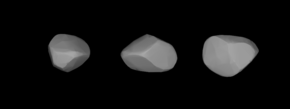 A three-dimensional model of 188 Menippe based on its light curve. | |
| Discovery | |
|---|---|
| Discovered by | C. H. F. Peters, 1878 |
| Discovery date | 18 June 1878 |
| Designations | |
| (188) Menippe | |
| Pronunciation | /mɛˈnɪpiː/[1] |
| A878 MA; 1897 QA; 1948 WQ | |
| Main belt | |
| Orbital characteristics[2] | |
| Epoch 31 July 2016 (JD 2457600.5) | |
| Uncertainty parameter 0 | |
| Observation arc | 100.84 yr (36833 d) |
| Aphelion | 3.2542 AU (486.82 Gm) |
| Perihelion | 2.2691 AU (339.45 Gm) |
| 2.7617 AU (413.14 Gm) | |
| Eccentricity | 0.17835 |
| 4.59 yr (1676.3 d) | |
| 346.69° | |
| 0° 12m 53.1s / day | |
| Inclination | 11.703° |
| 240.91° | |
| 70.177° | |
| Earth MOID | 1.286 AU (192.4 Gm) |
| Jupiter MOID | 2.07085 AU (309.795 Gm) |
| TJupiter | 3.288 |
| Physical characteristics | |
| 19.305±0.5 km | |
| 11.98 h (0.499 d) | |
| 0.2431±0.013 | |
| S | |
| 9.22 | |
188 Menippe is a main belt asteroid. The object has a bright surface and rocky composition. It was discovered by C. H. F. Peters on June 18, 1878, in Clinton, New York, and named after Menippe, one of the daughters of Orion in Greek mythology.
Photometric observations during 2010 showed a synodic rotation period of 11.98 ± 0.02 hours and a brightness variation of 0.28 ± 0.02 in magnitude. Because the rotation period is close to twelve hours, observations were needed at two widely separated observatories in order to build a light curve for the complete rotation.[3]
- ^ 'Menippa' in Noah Webster (1884) A Practical Dictionary of the English Language
- ^ "188 Menippe". JPL Small-Body Database. NASA/Jet Propulsion Laboratory. Retrieved 6 May 2016.
- ^ Cite error: The named reference
mpb37_4_143was invoked but never defined (see the help page).